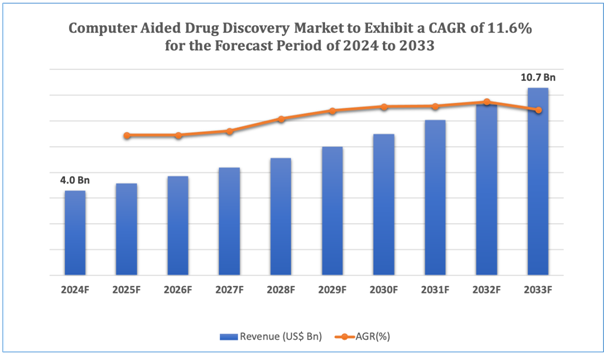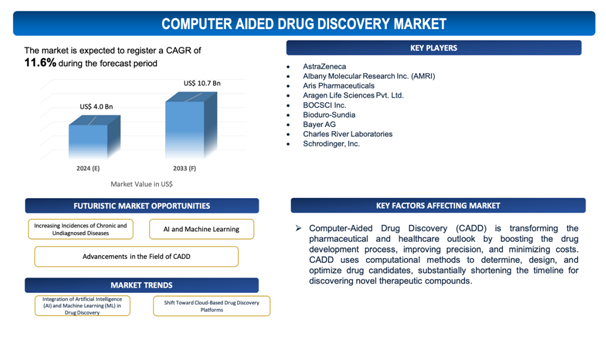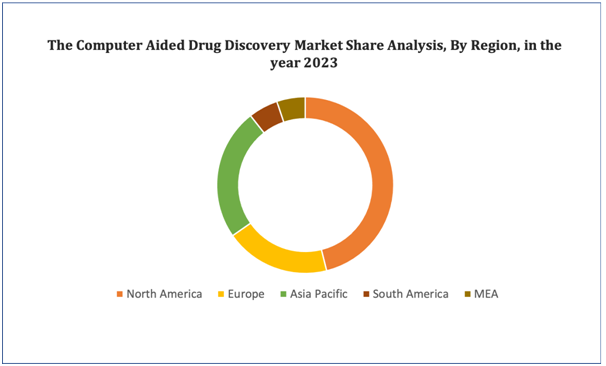Computer Aided Drug Discovery Market Overview
The global computer aided drug discovery market is estimated to be worth over USD 10.7Bn in 2033 and is expected to grow at CAGR of 11.6% during the forecast period (2024-2033).
Computer-Aided Drug Discovery (CADD) is transforming the pharmaceutical and healthcare outlook by boosting the drug development process, improving precision, and minimizing costs. CADD uses computational methods to determine, design, and optimize drug candidates, substantially shortening the timeline for discovering novel therapeutic compounds. Conventionally, drug discovery has been a lengthy and costly process comprising extensive lab-based trials. CADD, by simulating interactions between drugs and biological targets, allows researchers to predict outcomes more efficiently, minimizing the dependence on trial-and-error methods.
At the core of CADD are techniques such as molecular modelling, virtual screening, and quantitative structure-activity relationship (QSAR) analysis, which offer insights into the behaviour of molecules in biological systems. These techniquesallow researchers to determine promising drug candidates early in the process, decreasing the chances of failure in later-stage clinical trials. In addition, CADD improves the ability to design drugs for specific targets, enhancingefficiency and reducing side effects.
One of the most major impacts of CADD is its role in precision medicine. By leveraging huge amounts of biological data, CADD can be used to customize treatments to individual patients based on their genetic makeup. This customized approach has the potential to transform treatments for complex diseases such as cancer, neurodegenerative disorders, and cardiovascular conditions.
Latest advancements in artificial intelligence (AI) and machine learning (ML) are further amplifying the potential of CADD. AI-driven algorithms can analyse enormous datasets and identify patterns that were previously undetectable, improving the accuracy and speed of drug discovery. This integration of AI with CADD is expected to accelerate breakthroughs in drug development, especially in areas where traditional methods have struggled.
Moreover, CADD reduces the overall cost of drug development by identifying potential issues early in the pipeline and enabling researchers to focus on the most promising candidates. By streamlining the process and enhancing drug design, CADD is not only transforming how drugs are discovered but is also defining the future of pharmaceutical innovation, making treatments more efficient, personalized, and accessible.
Figure 1. Computer Aided Drug Discovery: Market Size

Get more details on this report - Request Free Sample
Key Market Insights
The global computer-aided drug discovery market is experiencingsignificant growth, fuelled by developments in computational technologies, the growing complexity of drug discovery processes, and the increasing demand for more efficient and cost-effective drug development methods. Latest insights reflect that the adoption of CADD is becoming a crucial component in pharmaceutical R&D as companies strive to boost drug discovery while minimizing costs and improving accuracy.
Recent developments in artificial intelligence (AI) and machine learning (ML) are transforming the CADD landscape. AI-driven platforms are now capable of analysing vast biological datasets, predicting molecular interactions, and determining potential drug candidates with unprecedented speed and precision. These technologies are allowing for the optimization of lead compounds and allowing more targeted drug design. Furthermore, quantum computing, though in its early stages, promises to further revolutionize CADD by solving complex molecular interactions that traditional computers struggle with.
Virtual screening, molecular docking, and structure-based drug design are among the key techniques used in CADD, helping streamline the drug discovery pipeline by identifying high-potential compounds earlier in the process. This minimizes the time and cost associated with laboratory-based screening and testing.
Pharmaceutical companies are increasingly investing in CADD tools to enhance their drug pipelines, especially in the development of treatments for diseases with high unmet medical needs such as cancer, neurodegenerative disorders, and rare diseases. The CADD market is poised for growth, facilitated by the surge of personalized medicine, where computational models tailor drugs to individual genetic profiles.
Market Dynamics
Market Drivers
Increased Incidences Of Chronic And Undiagnosed Diseases
The increased incidences of chronic and undiagnosed diseases are a primary driver for the global Computer-Aided Drug Discovery (CADD) market. Chronic diseases such as diabetes, cancer, cardiovascular diseases, and neurodegenerative disorders are on the surgeglobally, fuelled by geriatric populations, lifestyle factors, and environmental conditions. These diseases often require long-term treatment and complex therapeutic solutions, which challenge conventional drug discovery methods owing to the intricacies of disease mechanisms and patient variability.
CADD addresses these challenges by streamlining the drug discovery process, allowing researchers to design and develop more effective treatments in less time. For instance, CADD can model and simulate molecular interactions, helping scientists understand how potential drug compounds interact with biological targets specific to chronic diseases. This improves the ability to discover drugs that are not only more effective but also customized to individual patient needs, an approach aligned with the growing demand for personalized medicine.
Undiagnosed or rare diseases, which often lack effective treatments attributing to limited research, also benefit from CADD. By applying computational techniques such as virtual screening and molecular docking, CADD enables researchers to explore vast chemical libraries and identify drug candidates that might have otherwise been overlooked in traditional experimental settings. This propels the discovery of novel treatments for diseases with high unmet medical needs, providing hope for patients and fuelling the demand for more advanced drug discovery solutions.
As the global burden of chronic and undiagnosed diseases grows, CADD becomes a crucial tool for pharmaceutical companies aiming to develop innovative, targeted therapies.
Market Restraints
With regard to numerous advantages of computer aided drug discovery, the market faces several challenges due to the unique characteristics and requirements associated with these potent pharmaceutical products. Some of the key market challenges include:
- High Initial Investment and Operational Costs: Implementing CADD technologies needs significant upfront investment in sophisticated software, computational infrastructure, and skilled personnel. Smaller pharmaceutical companies or start-ups may find these costs prohibitive, deterring their ability to adopt CADD solutions on a wide scale.
- Complex Regulatory and Validation Challenges: Drugs discovered through CADD still need to undergo extensive clinical trials and regulatory approval processes. The lack of clear regulatory frameworks for computationally designed drugs can slow down the adoption of CADD technologies, as companies must ensure that the virtual findings align with real-world results and meet stringent regulatory standards.

Get more details on this report - Request Free Sample
Market Opportunity
Advancements in the Field Of Computer-Aided Drug Discovery
Advancements in the field of computer-aided drug discovery (CADD) present significant market opportunities for the global CADD market. Emerging technologies such as artificial intelligence (AI), machine learning (ML), and quantum computing are revolutionizing the drug discovery process by enabling faster and more accurate identification of potential drug candidates. These advancements allow researchers to predict molecular interactions, optimize lead compounds, and model complex biological systems with unprecedented precision, reducing the time and cost traditionally associated with experimental drug discovery methods.
AI and ML algorithms can analyze vast datasets, including genomic, proteomic, and biochemical information, to identify novel drug targets and predict their efficacy. This leads to more targeted drug design, particularly in personalized medicine, where treatments are tailored to individual genetic profiles. Furthermore, advancements in quantum computing hold the potential to solve complex molecular equations and predict protein folding, which could unlock new areas of drug discovery that are currently beyond the capabilities of classical computing.
These technological innovations are also expanding the scope of CADD beyond traditional pharmaceutical companies, enabling biotech start-ups and academic research institutions to leverage computational power to accelerate drug development. The growing integration of AI and cloud-based platforms further enhances collaboration between researchers globally, fostering innovation.
Overall, these advancements in CADD technologies represent a significant growth opportunity for the market, as they offer the potential to streamline drug discovery, improve success rates, and bring new, more effective therapies to market faster.
Market Trends
- Integration of Artificial Intelligence (AI) and Machine Learning (ML) in Drug Discovery: AI and ML technologies are increasingly being adopted to enhance drug discovery processes. These technologies enable predictive modelling, faster lead compound identification, and optimization, reducing the time and cost associated with traditional drug discovery methods. This trend is expected to grow as AI algorithms become more advanced and widely accessible.
- Shift Toward Cloud-Based Drug Discovery Platforms: Pharmaceutical companies and research institutions are increasingly utilizing cloud-based platforms for CADD. These platforms provide scalable computing power and facilitate global collaboration, allowing researchers to work on drug discovery projects remotely and share data in real time. This trend is particularly beneficial for small and mid-sized companies that may lack the resources for in-house computational infrastructure.
Computer Aided Drug Discovery Market: Key Segments
By Type
- Structure-based Drug Design
- Ligand-based Drug Design
- Sequence-based Approaches
By Therapeutic Area
- Oncology
- Neurology
- Cardiovascular diseases
- Respiratory diseases
- Diabetes
By End User
- Pharmaceuticals companies
- Biotechnology companies
- Research Laboratories
By Key Geographical Regions
- North America
- Europe
- Asia-Pacific
- Middle East and Africa
- South America
Figure 4. Computer Aided Drug Discovery Market: Distribution by Region

Get more details on this report - Request Free Sample
Computer Aided Drug Discovery Market: Regional Analysis
Based on the region, North America dominates the computer-aided drug discovery. The rising number of cancer cases in the United States is expected to boost revenue in the computer-aided drug discovery market. Cancer is one of the few most dangerous medical conditions with no cure, and the disease's prevalence is increasing at an alarming rate in the United States. According to the American Cancer Society, 1918030 new cancer cases will be diagnosed in 2022, with nearly 609360 people dying from the disease in the United States. In the search for a cancer cure, the use of computer-aided drug discovery has grown.
Leading Computer Aided Drug Discovery Developers
Industry Trends and Global Forecasts, 2023-2035 report features an extensive study of the current market landscape, market size and future opportunities associated with the Computer Aided Drug Discovery market, during the given forecast period. Further, the market report highlights the efforts of several stakeholders engaged in this rapidly emerging segment of the biopharmaceutical industry. Key takeaways of the Computer Aided Drug Discovery market are briefly discussed below.
The report includes the list of players operating in the global Computer Aided Drug Discovery market. Some of the key players include:
- AstraZeneca
- Albany Molecular Research Inc. (AMRI)
- Aris Pharmaceuticals
- Aragen Life Sciences Pvt. Ltd.
- BOCSCI Inc.
- Bioduro-Sundia
- Bayer AG
- Charles River Laboratories
- Schrodinger, Inc.
Computer Aided Drug Discovery Market: Key Developments
- In November 2023, QIAGEN has introduced a comprehensive Sample to Insight workflow tailored for microbiome research which is anticipated to accelerate research workflow which include whole genome metagenomics library preparation, DNA extraction kits, and bioinformatics analysis.
Scope of the Report
The market report presents an in-depth analysis of the various firms / organizations that are engaged in this market, across different segments, as defined in the below table:
|
|
Key Report Attributes |
Details |
||
|
|
Base Year |
2023 |
||
|
|
Forecast Period |
2024-2033 |
||
|
|
CAGR (2024-2033) |
11.6% |
||
|
|
Type |
|
||
|
|
Therapeutic Area |
|
||
|
|
End User |
|
||
|
|
Key Geographical Regions |
|
||
|
Key Companies Profiled |
|
|
||
